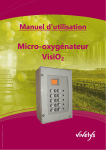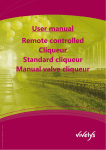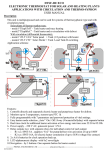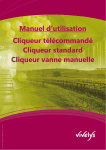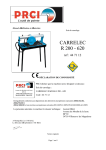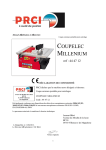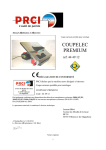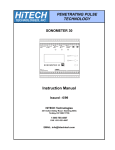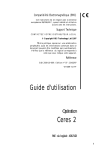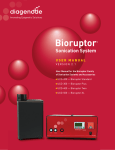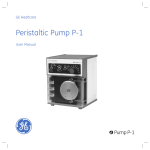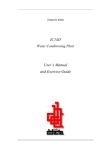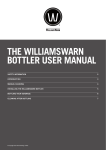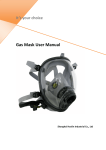Download Micro-oxygenator Compact
Transcript
User manual Micro-oxygenator Compact You have just purchased an Oenodev micro-oxygenator. Vivelys would like to thank you for the trust you have placed in it and is here to help you make your investment a success, both in terms of your wine and your profits. In nearly 15 years, now with Vivelys’ products, Oenodev has established itself as one of the great names in wine cellar oxygen control. Through its various international subsidiaries, the company now operates in all of the world’s wineproducing regions. To date, it has distributed 15,000 pieces of micro-oxygenation equipment/cliqueurs, including 1,800 tanks set up in 2008, and each year plays a part in the fermentation of 15 million hectolitres, almost 5% of world production, using effective oxygen management solutions throughout the process. The purpose of this manual is to provide as much information as possible on the product, how it works, and how to install and use it. For further information on your equipment or other products from our range, go to www.vivelys.com or contact us at [email protected]. 2 3 General safety advice Please read this manual in its entirety before unpacking, installing or using your new equipment. Pay particular attention to all of the use recommendations mentioned in this manual, especially “safety advice”. The information given in red denotes incorrect or dangerous use which may adversely affect the installation’s reliability or place the equipment and its user in danger. 1. Installation site Install the control box somewhere ventilated, not subject to any significant temperature changes, away from moisture and away from gangways. Do not use the equipment in an explosive atmosphere. 2. Gas supply The oxygen supply MUST NOT EXCEED 10 bar. The manufacturer cannot accept any liability if the maximum permissible pressure is exceeded. A special calibrated safety valve comes with the equipment. The gas used must be suitable for the supply. Gas must be used, bottles stored and the valve connected in accordance with recommendations and your supplier’s safety data sheets. Any use contrary to current safety requirements will discharge Vivelys of any liability whatsoever. Oxygen is combustible; the equipment must therefore be kept away from any source of intense heat. Do not smoke by it! 3. Power supply The box must not be supplied with voltage higher than that specified on the technical data sheet. An internal fuse protects the equipment. 4. General maintenance advice Do not open the equipment when it is switched on. Any change made to the equipment (electrical or pneumatic equipment) by the user will discharge the manufacturer of any liability. 4 Replacement parts used must be ordered from Vivelys or an approved supplier (a list of distributors is available at www.oenodev.com). When it is delivered, the equipment meets current technical requirements. The company director is responsible for ensuring that the equipment is kept in line with these technical requirements. For further information on micro-oxygenation equipment or associated offers, please visit our website or contact us. Domaine du Chapitre 170, boulevard du Chapitre 34750 Villeneuve-lès-Maguelone Tel : + 33 (0)4 67 85 68 40 Fax : + 33 (0)4 67 85 68 41 www.vivelys.com 5 Contents General safety advice ...............................................................................................................4 1. Installation site ..................................................................................................................................................................4 2. Gas supply ..........................................................................................................................................................................4 3. Power supply .....................................................................................................................................................................4 4. General maintenance advice .......................................................................................................................................4 Contents ........................................................................................................................................6 Technical features ......................................................................................................................7 Installation of physical parts ..................................................................................................8 1. Receiving the equipment ..............................................................................................................................................8 2. General installation diagram .......................................................................................................................................8 3. Detailed installation ........................................................................................................................................................8 Setting the installation.......................................................................................................... 13 1. Setting the valve pressure ......................................................................................................................................... 13 2. Switching on the equipment .................................................................................................................................... 13 3. Setting use parameters ............................................................................................................................................... 14 Limits ........................................................................................................................................... 17 Maintenance ............................................................................................................................. 18 1. Maintaining the diffuser ............................................................................................................................................. 18 2. Maintaining piping ....................................................................................................................................................... 20 3. Checking the seals ........................................................................................................................................................ 20 Spares and accessories ......................................................................................................... 23 FAQs – Troubleshooting ...................................................................................................... 24 Notes ........................................................................................................................................... 27 6 Technical features Commercial name: COMPACT Equipment type: wine production/storage equipment Equipment features: Box dimensions: height width depth 7.9 inches 11.8 inches 7.9 inches Box weight: 17.2 lbs Power supply: voltage frequency power insulation class 240 V AC 50/60 Hz 20 VA Class I (earth) oxygen max supply quality 10 bar Gas supply: Constituent materials coming into contact with wine (diffuser): Polyethylene Tube: supply Stainless steel body: 316 l nuance adapted to the supply contact Silicon joints: supply Ceramic part: supply in accordance with directive 84/500/CE 7 Installation of physical parts 1. Receiving the equipment The equipment is comprised of the following: 1 doser 2 tank outlets 2/4 1 ceramic diffuser in protective stainless steel casing, pre-fitted with a 10 m polyethylene supply pipe 50 metres of 2/4 mm polyamide tubing 1 tank cap crossover (tank inlet) 2 Norton tubes (‘noodles’) When you receive your equipment, please check your order and return the appended checklist. In the event of a problem, please contact us as soon as possible. Assembling your equipment in its entirety will also require the help of some flat keys (10 and 12), a cutting claw and a thumb wheel key. 2. General installation diagram (facultative) Oxygen bottle Pressure regulator Outlet fitting for regulator Quick connection bayonets (x2) 2/4 mm tube MOX unit/Micro-oxygenator Norton tube Tank top entry fitting Diffuser + immersion tube 8 3. Detailed installation All joints which will have to be connected and disconnected frequently are fitted with automatic seal connectors. Merely using the compact makes for a sealed link. Once disconnected, the female part is sealed automatically. Assembling and setting tank outlets: Setting up your equipment will require one or more tank outlets to be assembled on the 2/4 supply tubes. The tank outlet (components and on the general installation diagram) contains a sealing ring also termed an ‘olive’. It is essential to screw the olive to the supply tube to guarantee that it is securely connected and ensure that the equipment as a whole is sealed. To assemble it: Unscrew the tank outlet: Place the nut on the supply tube, the olive and the end of the tank outlet. Screw everything up again and tighten to make sure that the olive is inside using two flat keys. 9 The tank outlet is now held on the tube such that it will provide an excellent equipment seal. It is possible to unscrew the tank outlet to check that the olive is correctly set on the supply tube. Connecting the components: Fit the valve to the gas bottle ( → ) and connect the valve outlet to it ( → ). N.B.: using oxygen requires special equipment, especially an O2 compatible valve. Charledave valves, offered on our installation estimates, are specially designed for Oenodev equipment. The outlet must be screwed firmly using a key to ensure a hermetic seal. N.B.: do not use grease or Teflon to screw the outlet. Oxygen will explode in the presence of grease. 10 If it has not already been assembled, connect the first tank outlet to the tube as shown previously ( → ). Connect the whole / to the valve outlet (). Connect the other end of the tube to the distribution tee at the equipment inlet. Like at the tank outlet, this connection is also formed by screwing. The second tee inlet (on which there is a small black blocked tube) is used for serial assembly of several pieces of equipment using a single supply bottle. If necessary; leave it as it is. Cut about ten cm of supply tube (). Use it with the second tank outlet () by screwing it as explained previously. Connect a first Norton tube or ‘noodle’ () on the other side. The Norton tube provides sealing for up to 2 or 3 bars, thus guaranteeing additional safety in the event of accidental excess pressure. N.B.: only push the Norton tube 5 mm. The more it is pushed, the more it resists pressure. 11 Connect the assembly formed to the coupler on the doser outlet ( → ). Prepare the diffuser and its tube immersed () (as the assembly is already connected). As necessary, fit the crossover () to the immersed tube, no side screw on the outside. Connect the second Norton tube to the immersed tube ( → ). Connect the remaining length of tubing to the whole by joining it to the two Norton tubes, one placed on the doser side and the other placed on the immersed tube. N.B.: to begin micro-oxygenating your wine, it is better to set and launch the programme before installing the diffuser in the tank. To set it, please refer to the next chapter 12 Setting the installation 1. Setting the valve pressure Bottle Micro-oxygenator The valve has two manometers: The manometer on the left () shows the oxygen pressure in the bottle. It can be used to monitor the quantity of gas consumed, the pressure being 200 bars for a full bottle and falling gradually, to 0 when it is empty. The manometer on the right () shows the valve regulation pressure. This value may be adjusted using the thumb wheel found on the valve. The regulation pressure must remain stable, and is 6 bars for use in micro-oxygenation. The pressure must be adjusted on shutdown (with the joint detached for increased certainty). During injection, it is normal for the regulation pressure to fall slightly below the chosen value. It resets itself during the addition process. 2. Switching on the equipment There are two manometers on the front of the Compact: The manometer on the left shows the pressure at the diffuser outlet. It must normally be set at between 0.3 and 2 bars when the micro-oxygenation programme is switched on. 13 It should be noted that this pressure may not be set and depends on the amount of wine in the tank and how clean the ceramic part is. The manometer on the right shows the regulation pressure. While the equipment is in operation, it must always be set at 2.5 bars. This pressure is set using the grey regulator in the middle of the two manometers (to be pulled towards you before startup). When you first use your equipment, or at the beginning of the season after being switched off for a prolonged period, you must carry out a forced operation procedure in order to start or restart your equipment correctly. This operation entails completely opening the solenoids to rise to the adequate system counterpressure, i.e. 2.5 bars (this displayed on the regulation manometer). To do this, just operate with the diffuser outside the tank to prevent the wine quality from being altered. It is therefore advisable to carry out this operation having previously disconnected the assembly at the first noodle (the closest to the equipment). Simultaneously press the and buttons several times lightly (do not keep pressed otherwise the injection will be too powerful) and turn the regulator until the right manometer shows 2.5 bars. Once the regulation pressure has been set correctly, set the use doses in normal mode before fitting the diffuser to the tank. 3. Setting use parameters When you switch on the equipment, the Millennium 3 machine is set by default at a zero dose and on the tank volume you provided when your equipment was manufactured. The following screen is displayed: STOP To set the dose to be injected, press using this initial screen. 14 The following screen is displayed: DOSIS mL/L/MONTH 0000.0 0000.0 [OK] [A] < >[B] There are two lines in the display: the one at the top expresses the memory value (by default, this is zero) and the one at the bottom is the programming line where the desired value should be entered. The value is set by moving from one figure to the other with A (left) and B (right) and increasing or decreasing each flashing figure using the + and - buttons. DOSIS mL/L/MONTH 0000.0 0020.0 [OK] [A] [B] Example for 20mL/L/month: Press 2 times on A and 2 times on + Once the desired value has been set, press to submit. The chosen value is memorised and is copied into the line at the top: DOSIS mL/L/MONTH 0020.0 0020.0 [OK] [A] [B] N.B.: unless you submit, the value entered will not register. Once the dose has been programmed, press to access tank setting: 15 VOLUME TANK 0500.0 0000.0 [OK] [A] [B] By default, the value in the memory is the tank volume in hectolitres which you provided to Vivelys for manufacturing and setting your equipment. However, the tank volume is set in the same way as for the dose, i.e. buttons A and B, + and -. Once the tank volume has been checked or entered, press displayed: DOSIS V TANK . The following screen is 0020.0 0500.0 This is the screen which summarises the dose and the tank volume anticipated for the microoxygenation programme. It is this screen which will remain displayed throughout the micro-oxygenation period. To recap, the dose of oxygen is expressed in ml/l/month and the tank volume in hl. To switch off your doser, all you need to do is reset to zero the dose setting by entering a zero value. Then the following screen will be displayed instead of the summary screen: STOP 16 Limits Your equipment is primarily intended for the tank volume provided when you placed your order. The dosing chamber incorporated in your equipment is specially designed for this volume, termed the benchmark volume. In general, it is considered that the benchmark volume is the equivalent of a maximum tank volume to be micro-oxygenated. But there is nothing to stop you entering into the machine a greater tank volume than the benchmark volume, though you should avoid entering values. There is no minimum tank volume but if the content to be micro-oxygenated is very low in terms of the benchmark volume, injections will be widely spaced and the flow continuity not as good. N.B.: if a programmed value is not reached, the machine will not register it. Check the top line to see whether the value entered was indeed copied. The use limits common to all equipment are: Tank volume (in hl) Benchmark volume (in hl) Dose added (in ml/l/month) Minimum 1 50 0,1 Maximum 3000 5000 200 Any unit of volume may be used provided that the same unit is used for Tank and Benchmark volumes and the dosing chamber is actually at the benchmark volume (e.g. 500 hl = 5ml). In the event of any doubt, contact a Oenodev technician. By default, the units used are hl. The following table also shows your equipment’s use limits according your equipment’s initial dosing chamber (benchmark volume) and the volume of the tank to be used: Min/maxtank Volbenchmark Vol 50 100 250 10 100 250 500 1000 2000 5000 0.4 - 200 0.7 - 200 0.1 - 90 0.1 - 180 0.1 - 2 0.1 - 36 0.1 - 9 0.1 - 18 0.1 - 4,5 0.1 - 9 0.1 - 1.8 0.1 - 3.6 1.6 - 200 0.2 - 200 0.1 - 22.5 0.1 - 9 0.3 - 200 0.1 - 90 0.1 - 45 0.1 - 18 6.3 - 200 12.5 200 31,3 200 0.7 - 200 0.1 - 90 0.1 180 0.2 200 0.3 200 0,7 200 0.1 - 45 3.2 - 200 0.1 - 40 0.1 - 72 0.1 180 0.2 200 0.3 200 0.5 200 1,3 200 0.1 - 180 0.1 - 90 0.1 - 36 1.3 - 200 0,4 - 200 0.1 - 180 0,2 - 200 0.1 - 72 0,1 - 180 500 1000 2000 5000 1.3 - 200 3,2 - 200 17 Maintenance 1. Maintaining the diffuser The diffuser is a key equipment component. Never leave a diffuser out of use in the wine for more than a few hours. Never leave the ceramic part dipped for a long period. Never brush, scrape or touch the ceramic part in the diffuser. When should a diffuser be cleaned? We recommend cleaning the diffuser each time you use it. It should be cleaned when it becomes clogged (if this happens there will be a 2.5-bar or more increase in diffusion pressure), or when it is going to be stored dry after it has been used. Standard cleaning procedure The procedure requires a washer and drier. These come with the valve. Washer Drier The drier is the small elbow-shaped metal joint and the washer the brass female coupler. The latter is connected to a “gardening hose” type adaptor which can be used to attach it directly to the tap. If you received your washer before 2001, it may not have a tap adaptor. You can buy them in our shop. To clean your diffuser: Disconnect entire immersed tube/diffuser from the second “noodle” () Connect the immersed tube/diffuser to the drier, and the drier (male socket) to the washer (female socket) then connect the washer to a pipe/tap/source of hot water before passing water into the diffuser for a few minutes. Disconnect the diffuser. Dip the stainless steel body (do not dip the polyethylene pipe) into a bucket containing a javel-type solution from our shop, or in a 10% oxygenated water solution (percarbonate) Do not leave it dipped for more than an hour. 18 Reattach the diffuser to the washer-drier and rinse by letting water (hot or cold) circulate for 2 mins, then dip it into a bisulphite solution to neutralise any residue. Again, rinse with water. To dry it, disconnect the drier from the washer and connect it to the valve outlet (). Blow the oxygen through the ceramic part until the foam in the cylinder disappears (about 2 mins). If you then need to store the diffuser for a long period, we recommend leaving it to dry longer (about 5 mins). To perform this operation, you can also use another gas, clean and without any traces of grease (compressed air/nitrogen/argon). A ceramic part stored damp will quickly become a source of moisture Comments: Store diffusers in a clean, dry place. Clean the diffuser as often as possible (water + oxygen drying), for example when changing tank or during temporary shutdown. Check regularly that the diffuser is working properly. When it is immersed in the wine, you should see a fine foam on the surface. If the ceramic part is damaged, the bubbles produced will be larger. But beware, as the bubbles always appear to be larger in water than wine. If the ceramic part becomes damaged, the diffusion pressure measured by the micro-oxygenator will be almost equal to the hydrostatic pressure exerted on the ceramic part (lower than the diffusion pressure during normal operation). Complete cleaning/unclogging procedure: Remove the diffuser by unscrewing its joint to the supply tube using two flat keys. Remove the screws at the bottom of the diffuser and the metal washer. Carefully remove the red silicon seal at the bottom of the diffuser. Gently shake the ceramic part until it comes away. NEVER TOUCH THE INSIDE OF THE CYLINDER. Remove the upper silicon seal. Place the metal and silicon parts in a plastic container (about 1 l). Place the ceramic parts in a 250 ml Pyrex beaker. Place the stainless steel body and the polyethylene piping (rolled up in advance) in a plastic bucket (8/10 l). Dip the ceramic part in a 50% javel solution (which may be purchased from our shop) for 2 hrs. 19 Rinse the ceramic part thoroughly in water. Place it in an ultrasound bath for 45 minutes. These stages may be repeated until the ceramic part looks clean. Follow safety procedures when using chemicals. Dip each metal part, the stainless steel body and the polyurethane pipe in a percarbonate/hot water solution for 30 minutes. Then dip them into a citric acid/hot water solution for 10 minutes. Rinse thoroughly in water (allow water from the washer to pass through the pipe). Follow safety procedures when using chemicals. When all parts have been cleaned, reassemble the diffuser and test the outlet pressure. If the outlet pressure test is satisfactory, store the diffuser in a clean, dry place or put it back into service. If the diffuser has to be stored, you must guarantee that it is completely dry to prevent any damp from appearing on the ceramic part. 2. Maintaining piping Once the piping has been installed correctly, in accordance with the explanations given in this manual, piping does not need any particular maintenance. 3. Checking the seals If you note any excessive gas consumption (oxygen or nitrogen), there may be a leak in your equipment’s supply. If you see anything like this, here is the checking procedure to be followed. Stage 1: check the valve seal: Your valve is designed as follows: The manometer on the left () shows the oxygen pressure in the bottle. It can be used to monitor the quantity of gas consumed, the pressure being 200 bars for a full bottle and falling gradually, to 0 when it is empty. The manometer on the right () shows the regulation pressure. This value may be adjusted using the thumb wheel found on the valve. The regulation pressure must remain static, and is 1 (barrel) or 3 (tank) for clicking and 6 for microoxygenation. 20 To check: Disconnect the supply at the quick joint to that you can carry out the test on the valve alone. Open the gas bottle and set the outlet pressure (which may be checked on ) to 6 bars. Enter the bottle pressure on manometer , and close the bottle. Wait a few minutes, reset the pressure and then reopen the supply. If the pressure is at the same level as in the first check, your system’s valve is sealed. Go to the next stage. If the pressure on manometer is very different, the valve has failed. If, when the supply was shut off, the pressure on has fallen or you have noticed a shift on the dial at the bottle opening, your equipment has a leak. Then check that the valve is correctly screwed to the bottle and that the outlet joint is correctly screwed to the valve (the two must be mounted without any Teflon). If they are reliable, check the seal on the outlet joint using a Gazobul aerosol leak detector or by dipping it in water. If there is a leak, replace the outlet joint. Check it again after it has been repaired. If all of the checks are satisfactory but you still note leakage problems, replace the valve (contact Vivelys) We recommend that you work on your equipment with original Vivelys valves: our manufacturer modifies them specifically to guarantee the fine tuning necessary for them to work with our equipment. Stage 2: Checking the equipment’s supply circuit: Reconnect the equipment to the valve without programming any dose so that the equipment does not start up. Open the bottle and set the outlet pressure () based on use pressure (1 or 3 bars for a cliqueur, 6 bars for a micro-oxygenator). Enter the bottle pressure on , and close the bottle. Wait a few minutes, reset the pressure and then reopen the supply. If the pressure does not change, the equipment has no leaks. 21 If the pressure on has fallen while the bottle was closed or you have noticed a shift on the dial at the bottle opening, your equipment has a leak. As this is not coming from the valve (you checked this in stage 1), carry out the following checks: Check the seal on the valve outlet (on the quick joint) using a Gazobul leak detector or by dipping it in water. If you find a leak, replace the valve outlet (this is the most commonly found breakdown) and, if necessary, the tank outlet connection which is associated with it. Check the state of the supply pipe: It must not be kinked or pierced, as this would cause serious risk of a leak. Replace it if necessary. Check the seal on the equipment’s inlet joint and replace it if necessary. After any repairs, double check everything. If you still find any leaks, the problem could be with your doser. Please contact Vivelys after-sales service quickly. 22 Spares and accessories Here are the spares most used by your after-sales service for troubleshooting. If you have a more specific request, or need assistance or a technician, feel free to contact us. Diffuser + immersed tube (1.5.2DiffuseurMicro) Bare ceramic part (1D.C050) Diffuser seals (1D.C051) Tank outlet 2/4 (1.5.2DEPARTCUVE2/4)) Doser outlet 2/4 (1.6SortieDoseur2/4) Crossover (1.6EntréeCuveNue) 3 cm Norton tube (included in the troubleshooting kit) Brass olive Stainless steel olive (included in the troubleshooting kit) (included in the troubleshooting kit) Valve outlet (3.1.SD1) Washer (3.1.LV1) Drier (3.1.SE1) Micro repair kit (1.6KitSAVmicro) Millennium 3 machine (1C.COMP0031) Tube clip (1Q.PT201) Rilsan tube roll 2/4 (50m) Rilsan tube roll 2/7 (100 m) (1.5.2Rislan50M) (1.6Rislan100M) 23 FAQs – Troubleshooting Here are some potential solutions to the problems most commonly encountered by users of our equipment. Feel free to contact our after-sales service for advice further to that below or if you have not found a solution to your problem. OBSERVATION No machine display CHECK TO BE MADE Is the equipment connected to a power supply? NO Connect the equipment YES NO The machine has failed. Contact after-sales service. NO The machine has failed. Contact after-sales service. NO Set the bottle outlet pressure to 6 bars. The supply or screen has failed. Contact after-sales service. The machine has crashed Disconnect and reconnect the equipment to reinitialise it. YES The equipment is ready for use. Check that the bottle pressure is indeed 6 bars. YES Everything works but nothing comes out, even when switched on by force. Check that the counter pressure on the right manometer is indeed 2.5 bars. NO YES NO The circuit is blocked. Contact aftersales service. Check that the oxygen cylinder is securely connected or open. NO Connect and open the cylinder. Check that the valve pressure is indeed 6 bars. NO Set the valve pressure to 6 bars. Switch on by force using small impulses by turning the regulator clockwise to 2.5 bars. NO The regulator or solenoid has failed. Contact aftersales service. Check that the pressure on the left manometer is not above 2.5 bars. NO YES The right hand manometer is below 2.5 bars The right hand manometer is above 2.5 bars Tap the black screw on the side of the regulator with a screwdriver; a solenoid may be stuck. The solenoid has failed. Contact after-sales service. YES YES The equipment’s outlet connection is not connected or is not connected securely. Check the regulator setting by turning it anticlockwise. If you cannot do this, the regulator has failed. Contact after-sales service. 24 The pressure on the right hand manometer is not reaching 2.5 bars Fully unscrew the regulator, switch on by force and then reset the pressure to 2.5 bars. NO There is an internal leak in the doser module. Contact after-sales service. Switch on by force to find out whether the solenoids are working. NO The solenoid has failed. Contact after-sales service. YES Clean the ceramic part (procedure page 18). YES Repair the joint using a stainless steel olive or replace the complete tube (references page 21) YES Clean or replace the equipment outlet joints. YES Clean the ceramic part (procedure page 18). NO The equipment’s internal circuit is blocked. Contact after-sales service. YES Clean the ceramic part (procedure page 18). YES Replace the blocked pipe. YES Check that the connections to the Norton tubes are not disconnected. The left manometer pressure is still 0. NO Check that the pipe is not cut at the diffuser and that the ceramic part is not broken. NO There is a leak on the line (pierced pipe). Check whether the equipment’s outlet connection is connected or is not connected securely (potential risk of rust at the joint). NO The ceramic part is clogged. The left hand manometer is greater than 2 bars. NO Check that the pipe between the equipment and the diffuser is not blocked or dented. Disconnect the diffuser at the tank’s Norton tube. Switch on by force: The air must leave freely and the left manometer will fall immediately. YES Replace the blocked pipe. Check that the diffuser is not clogged. NO The Norton tube (noodle) at the equipment outlet comes away constantly. Check that the pipe between the equipment and the diffuser is not blocked or dented. Disconnect the diffuser to test the line. NO The doser module has failed. Contact after-sales service. 25 Check that there is indeed a dose and a tank volume programmed. NO Enter a dose on ml/l/month and a tank volume in hl. Check that the dose programmed is compatible with the equipment. NO Contact after-sales service. YES The equipment does not work automatically. YES The machine has lost its benchmark values. Contact after-sales service. The equipment does not work and the machine shows an error code. Oxygen consumption is too high. The machine has lost its programme. Contact after-sales service. Check that there is no leak in the circuit. See the seal check procedure. NO Contact after-sales service. YES Repair using the same procedure. 26 Notes ................................................................................................................................................................................................... ................................................................................................................................................................................................... ................................................................................................................................................................................................... ................................................................................................................................................................................................... ................................................................................................................................................................................................... ................................................................................................................................................................................................... ................................................................................................................................................................................................... ................................................................................................................................................................................................... ................................................................................................................................................................................................... ................................................................................................................................................................................................... ................................................................................................................................................................................................... ................................................................................................................................................................................................... ................................................................................................................................................................................................... ................................................................................................................................................................................................... ................................................................................................................................................................................................... ................................................................................................................................................................................................... ................................................................................................................................................................................................... ................................................................................................................................................................................................... ................................................................................................................................................................................................... ................................................................................................................................................................................................... ................................................................................................................................................................................................... ................................................................................................................................................................................................... ................................................................................................................................................................................................... ................................................................................................................................................................................................... ................................................................................................................................................................................................... ................................................................................................................................................................................................... ................................................................................................................................................................................................... ................................................................................................................................................................................................... ................................................................................................................................................................................................... ................................................................................................................................................................................................... ................................................................................................................................................................................................... ................................................................................................................................................................................................... ................................................................................................................................................................................................... ................................................................................................................................................................................................... ................................................................................................................................................................................................... ................................................................................................................................................................................................... ................................................................................................................................................................................................... ................................................................................................................................................................................................... ................................................................................................................................................................................................... ................................................................................................................................................................................................... ................................................................................................................................................................................................... ................................................................................................................................................................................................... ................................................................................................................................................................................................... ................................................................................................................................................................................................... ................................................................................................................................................................................................... 27 ................................................................................................................................................................................................... ................................................................................................................................................................................................... ................................................................................................................................................................................................... ................................................................................................................................................................................................... ................................................................................................................................................................................................... ................................................................................................................................................................................................... ................................................................................................................................................................................................... ................................................................................................................................................................................................... ................................................................................................................................................................................................... ................................................................................................................................................................................................... ................................................................................................................................................................................................... ................................................................................................................................................................................................... ................................................................................................................................................................................................... ................................................................................................................................................................................................... ................................................................................................................................................................................................... ................................................................................................................................................................................................... ................................................................................................................................................................................................... ................................................................................................................................................................................................... ................................................................................................................................................................................................... ................................................................................................................................................................................................... ................................................................................................................................................................................................... ................................................................................................................................................................................................... ................................................................................................................................................................................................... ................................................................................................................................................................................................... ................................................................................................................................................................................................... ................................................................................................................................................................................................... ................................................................................................................................................................................................... ................................................................................................................................................................................................... ................................................................................................................................................................................................... ................................................................................................................................................................................................... ................................................................................................................................................................................................... ................................................................................................................................................................................................... ................................................................................................................................................................................................... ................................................................................................................................................................................................... ................................................................................................................................................................................................... ................................................................................................................................................................................................... ................................................................................................................................................................................................... ................................................................................................................................................................................................... ................................................................................................................................................................................................... ................................................................................................................................................................................................... ................................................................................................................................................................................................... ................................................................................................................................................................................................... ................................................................................................................................................................................................... ................................................................................................................................................................................................... ................................................................................................................................................................................................... ................................................................................................................................................................................................... ......................................................................................................................................................................................... 28 Domaine du Chapitre 170, bd du Chapitre 34750 Villeneuve-lès-Maguelone France Tél. : +33 (0)4 67 85 68 40 – Fax : +33 (0)4 67 85 68 41 www.vivelys.com – [email protected]





























